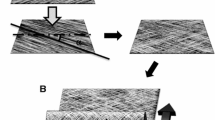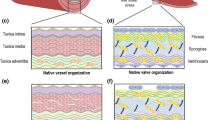Abstract
The anisotropic collagen architecture of an engineered cardiovascular tissue has a major impact on its in vivo mechanical performance. This evolving collagen architecture is determined by initial scaffold microstructure and mechanical loading. Here, we developed and validated a theoretical and computational microscale model to quantitatively understand the interplay between scaffold architecture and mechanical loading on collagen synthesis and degradation. Using input from experimental studies, we hypothesize that both the microstructure of the scaffold and the loading conditions influence collagen turnover. The evaluation of the mechanical and topological properties of in vitro engineered constructs reveals that the formation of extracellular matrix layers on top of the scaffold surface influences the mechanical anisotropy on the construct. Results show that the microscale model can successfully capture the collagen arrangement between the fibers of an electrospun scaffold under static and cyclic loading conditions. Contact guidance by the scaffold, and not applied load, dominates the collagen architecture. Therefore, when the collagen grows inside the pores of the scaffold, pronounced scaffold anisotropy guarantees the development of a construct that mimics the mechanical anisotropy of the native cardiovascular tissue.









Similar content being viewed by others
References
Argento G, Simonet M, Oomens CWJ, Baaijens FPT (2012) Multi-scale mechanical characterization of scaffolds for heart valve tissue engineering. J Biomech 45(16):2893–2898
Bhole AP, Flynn BP, Liles M, Saeidi N, Dimarzio CA, Ruberti JW (2009) Mechanical strain enhances survivability of collagen micronetworks in the presence of collagenase: implications for load-bearing matrix growth and stability. Philos T R Soc A Math Phys Eng Sci 367(1902):3339–3362
Billiar KL, Sacks MS (2000a) Biaxial mechanical properties of the natural and glutaraldehyde treated aortic valve cusp-part i: experimental results. J Biomech Eng 122(1):23–30
Boerboom RA, Rubbens MP, Driessen NJB, Bouten CVC, Baaijens FPT (2008) Effect of strain magnitude on the tissue properties of engineered cardiovascular constructs. Ann Biomed Eng 36(2):244–253
Dahl SL, Vaughn ME, Hu JJ, Driessen NJ, Baaijens FPT, Humphrey JD, Niklason LE (2008) A microstructurally motivated model of the mechanical behavior of tissue engineered blood vessels. Ann Biomed Eng 36(11):1782–1792
de Jonge N, Kanters FM, Baaijens FP, Bouten CVC (2012) Strain-induced collagen organization at the micro-level in fibrin-based engineered tissue constructs. Ann Biomed Eng 41(4):763–774
de Jonge N (2013) Guiding collagen orientation at the micro-level in engineered cardiovascular tissues. PhD thesis, Eindhoven University of Technology
Driessen N, Bouten C, Baaijens F (2005) Improved prediction of the collagen fiber architecture in the aortic heart valve. J Biomech Eng 127(2):329–336
Driessen NJB, Mol A, Bouten CVC, Baaijens FPT (2007) Modeling the mechanics of tissue-engineered human heart valve leaflets. J Biomech 40(2):325–334
Driessen NJB, Cox MAJ, Bouten CVC, Baaijens FPT (2008) Remodeling of the angular collagen fiber distribution in cardiovascular tissues. Biomech Model Mechanobiol 7:93–103
Eckert CE, Mikulis BT, Gottlieb D, Gerneke D, LeGrice I, Padera RF, Mayer JE, Schoen FJ, Sacks MS (2011) Three-dimensional quantitative micromorphology of pre- and post-implanted engineered heart valve tissues. Ann Biomed Eng 29(1):205–222
Erisken C et al (2013) Scaffold fiber diameter regulates human tendon fibroblast growth and differentiation. Tissue Eng A 19(3–4):519–528
Foolen J, Deshpande VS, Kanters FMW, Baaijens FPT (2012) The influence of matrix integrity on stress-fiber remodeling in 3D. Biomaterials 33:7508–7518
Frangi AF, Niessen WJ, Vincken KL, Viergever MA (1998) Medical image computing and computer-assisted interventation. In: MICCAI98, pp 130–137
Gasser TC, Ogden RW, Holzapfel GA (2006) Hyperelastic modelling of arterial layers with distributed collagen fibre orientations. J R Soc Interface 3(6):15–35
Hadi M, Sander E, Ruberti J, Barocas V (2012) Simulated remodeling of loaded collagen networks via strain-dependent enzymatic degradation and constant-rate fiber growth. Mech Mater 44:72–82
Hill R (1963) Elastic properties of reinforced solids: some theoretical principles. J Mech Phys Solids 11:357–372
Hill R (1984) On macroscopic effect of heterogeinity in elastoplastic media at finite strains. Math Proc Camb Phil Soc 95:481–494
Huang C, Yannas IV (1977) Mechanochemical studies of enzymatic degradation of insoluble collagen fibers. J Biomed Mater Res 11(8):137–154
Huszar G, Maiocco J, Naftolin F (1980) Monitoring of collagen and collagen fragments in chromatography of protein mixtures. Anal Biochem 105:494–499
Hwang C, Park Y, Park J, Lee K, Sun K, Khademhosseini A, Lee S (2009) Controlled cellular orientation on plga microfibers with defined diameters. Biomed Microdev 11(4):739–746
Kouznetsova V, Brekelmans WAM, Baaijens FPT (2001) An approach to micro-macro modeling of heterogeneous materials. Comput Mech 27:37–48
Krahn KN, Bouten CVC, van Tuijl S, van Zandvoort MA, Merkx M (2006) Fluorescently labeled collagen binding proteins allow specific visualization of collagen in tissues and live cell culture. Anal Biochem 350(2):177–185
Langer R, Vacanti JP (1993) Tissue engineering. Science 260(5110):920–926
Lee CH et al (2005) Nanofiber alignment and direction of mechanical strain affect the ecm production of human acl fibroblast. Biomaterials 26(11):1261–1270
Menten L, Michaelis MI (1913) Die kinetik der invertinwirkung. Biochem Z 49:333–369
Mol A (2005) Functional tissue engineering of human heart valve leaflets. PhD thesis, Eindhoven University of Technology
Mol A, van Lieshout MI, Dam-de Veen CG, Neuenschwander S, Hoerstrup SP, Baaijens FP, Bouten CV (2005) Fibrin as a cell carrier in cardiovascular tissue engineering applications. Biomaterials 26(16):3113–3121
Mol A, Rutten M, Driessen N, Bouten CVC, Zünd G, Baaijens FPT, Hoerstrup SP (2006) Autologous human tissue-engineered heart valves prospects for systemic application. Circulation 114(1 suppl):152–158
Nemat-Nasser S (1999) Averaging theorems in finite deformation plasticity. Mech Mater 31:493–532
Niklason LE, Yeh AT (2009) Enabling tools for engineering collagenous tissues integrating bioreactors, intravital imaging, and biomechanical modeling. Proc Natl Acad Sci USA 107:3335–3339
Rubbens MP, Mol A, Boerboom RA, Bank RA, Baaijens FPT, Bouten CVC (2009) Intermittent straining accelerates the development of tissue properties in engineered heart valve tissue. Tissue Eng A 15(5):999–1008
Schnell AM, Hoerstrup SP, Zund G, Kolb S, Sodian R, Visjager JF, Grunenfelder J, Suter A, Turina M (2001) Optimal cell source for cardiovascular tissue engineering: venous vs. aortic human myofibroblasts. Thorac Cardiovasc Surg 49(4):221–225
Soares ALF, Stekelenburg M, Baaijens FPT (2011) Remodeling of the collagen fiber architecture due to compaction in small vessels under tissue engineered conditions. J Biomech Eng 133(7):071,002
Subramony SD et al (2013) The guidance of stem cell differentiation by substrate alignment and mechanical stimulation. Biomaterials 34(8):1942–1953
Teh TK, Toh SL, Goh JC (2013) Aligned fibrous scaffolds for enhanced mechanoresponse and tenogenesis of mesenchymal stem cells. Tissue Eng A 19:1360–1372
Van Geemen D (2012) Tissue properties and collagen remodeling in heart valve tissue engineering. PhD thesis, Eindhoven University of Technology
van Vlimmeren M, Driessen-Mol A, Oomens C, Baaijens F (2012) Passive and active contributions to generated force and retraction in heart valve tissue engineering. Biomech Model Mechanobiol 11(7):1015–1027
Walters BD, Stegemann JP (2013) Strategies for directing the structure and function of 3D collagen biomaterials across length scales. Acta Biomater 10(4):1488–1501
Wisse E, Spiering A, van Leeuwen E, Renken R, Dankers P, Brouwer L, van Luyn M, Harmsen M, Sommerdijk N, Meijer E (2006) Molecular recognition in poly(epsilon-caprolactone)-based thermoplastic elastomers. Biomacromolecules 7(12):3385–3395
Wyatt KEK, Bourne JW, Torzilli PA (2009) Deformation-dependent enzyme mechanokinetic cleavage of type I collagen. J Biomech Eng 131(5):051004
Acknowledgments
This research forms part of the Project P1.01 iValve of the research program of the BioMedical Materials institute, co-funded by the Dutch Ministry of Economic Affairs. The financial contribution of the Nederlandse Hartstichting is gratefully acknowledged. The authors gratefully thank Marc Simonet for the electrospinning of the scaffolds.
Author information
Authors and Affiliations
Corresponding author
Rights and permissions
About this article
Cite this article
Argento, G., de Jonge, N., Söntjens, S.H.M. et al. Modeling the impact of scaffold architecture and mechanical loading on collagen turnover in engineered cardiovascular tissues. Biomech Model Mechanobiol 14, 603–613 (2015). https://doi.org/10.1007/s10237-014-0625-1
Received:
Accepted:
Published:
Issue Date:
DOI: https://doi.org/10.1007/s10237-014-0625-1




